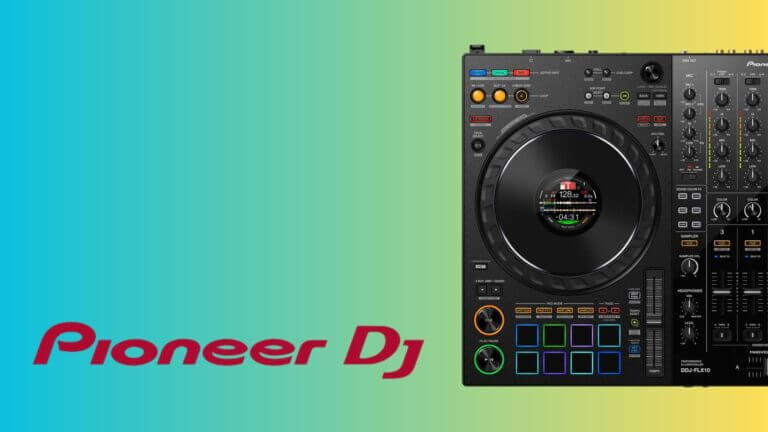While Pioneer DJ has always made a name for itself as one of the foremost DJ gear providers, they’ve only been able to do that by having a very impressive catalog of controllers and devices compared to its competition.
For the past five years, that sentiment has been focused squarely on the DJ DDJ-1000 and DDJ-1000SRT Pioneer DJ controller units.
These two have been the veritable standard and benchmark of the Pioneer DJ brand thanks to their long-lasting features and incredible sounding effects. Now, a new controller, the Pioneer DJ DDJ-FLX10, has come out and it’s slated to be the spiritual successor in virtually every way imaginable, becoming the new benchmark standard for all controllers in the next five years.
The Pioneer DJ DDJ-FLX10 DJ controller, while a bit more expensive, holds itself as one of the best controllers on the market, with features and functions that put it well above virtually any controller out there, even having options for Serato despite being a Rekordbox native device.
In this article, we go over the ins and outs of the controller to see if it manages to succeed as the next step from the highly successful and widely praised Pioneer DJ DDJ-1000, or if it’s a very well-meaning and expensive device that, while good, still doesn’t quite reach the heights as what was done over five years ago.
- Extensive Performance Features
- Jogwheels With Screens
- Professional 4-Channel Mixer
- Integrated Stem Controls
- Stem Quality is Sometimes Average
Is the Pioneer DJ DDJ-FLX10 any good?
If you’re a professional performer, there’s really no excuse not to pick this up. Not only will it be cheaper in the long term, but when you consider just what it’s bringing to the table, it’s clear that, whether you’re a Serato or a rekordbox DJ fan, this is the thing you should be playing with.
The DDJ-FLX10 is a 4-channel DJ performance controller compatible with rekordbox and Serato DJ Pro. It introduces numerous novel features, including Track Separation technology. This technology allows for innovative capabilities such as effortlessly performing mash-ups in real-time, eliminating the need for pre-arranged tracks.
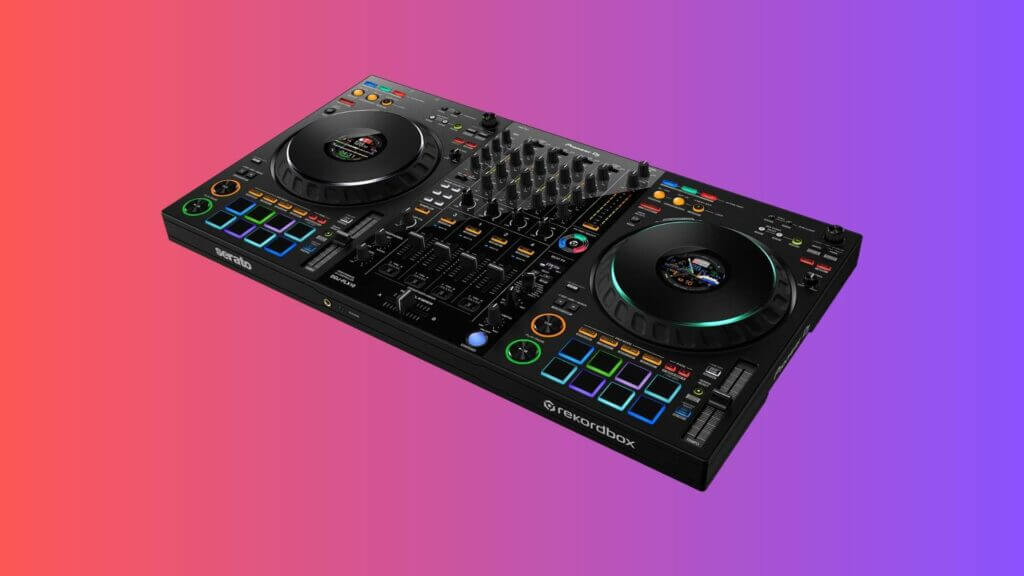
First Impressions
From an initial first impression, both at what the controller looks and feels like as well as what it’s got under the hood and available for its users, it’s clear they weren’t kidding when they said this was the new flagship for the company.
It stands as the third in the “FLX group” after the FLX4 and FLX6/GT. It is the first controller to utilize Pioneer DJ’s “track separation features” (also known as stems) which have increasingly become popular in DJ devices. These include options like Part Instant Doubles, switching out the EQs for control stems, as well s using the FX Part Select.
The Mix Point Link acts as a semi-automating option for putting together DJ mixes while also offering a DMX socket for lighting effects.
Build
Starting off, when pulling out of the box and setting up, one of the first things you’re going to pick up on is the fact that this controller stands apart from the Pioneer DJ DDJ-1000 and DDJ-1000SRT simply by the fact that it is compatible with both rekordbox as well as Serato DJ suite.
This was a huge contention for Pioneer DJ’s last flagship and ultimately resulted in them making the two separate controllers just to fix.
In terms of the overall build, it follows much in the DDJ-1000’s path, having a fairly durable setup with a lot of quality plastic in places. It hosts two USB type-C ports at its back. This is now in place of the older type-B that was normally used. This means that your computer and laptop should ideally either have a native type-C port or an adaptor.
And that’s all there is. Because the controller is entirely standalone, it doesn’t need or require a ton of cables in the back to connect to a slew of devices. Simply tie it to your laptop and you’re good to go.
Design
Though the build certainly has a lot of incredible aspects to it, there’s just as much to love when it comes to the overall look and feel of the FLX10.
Here, it’s clear they wanted to make it as much of a spiritual successor to the DDJ-1000 and DDJ-1000SRT as possible.
It has the same club-like layout to it while also carrying a splash of “controllerism” to it for good measure. This means, in addition to the aforementioned full-size jogwheels, the controller also offers controller-style pads as well as hot cue buttons in two rows of four rather than one row of eight.
The FLX10 has also greatly improved on the jog wheels in-jog display, allowing them to display parallel waveforms as well as have multi-colored rings.
Both of these features are really cool to look at, though the new multi-colored rings are great since they show you what stem you’re currently using (more on that later) since they share the same color when used.
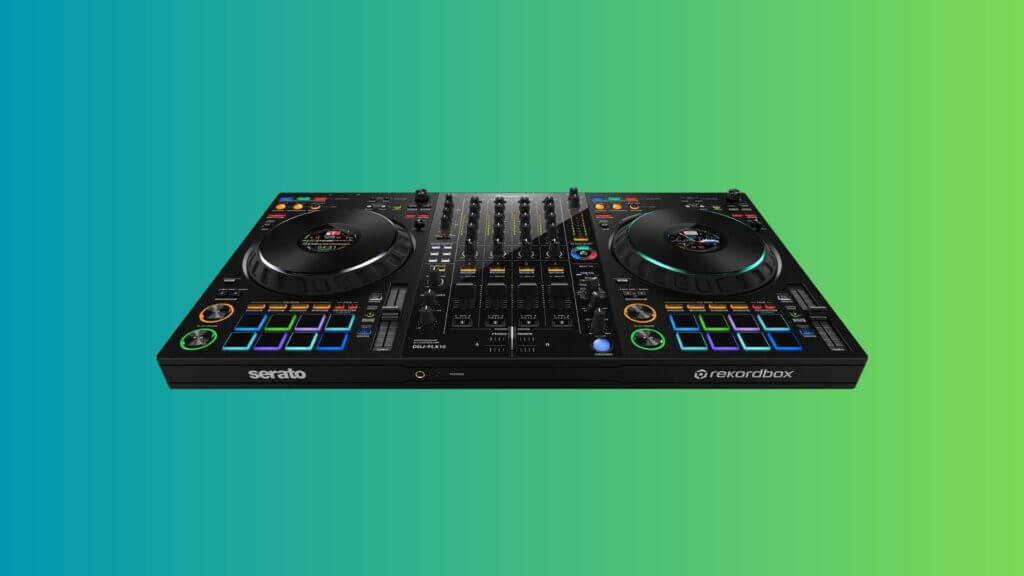
A Deeper Look
Mix Point Link
The Mix Point Link is a fairly cool and interesting feature found on the Pioneer DJ DDJ FLX10. This allows you to set mix points on the following track, designating a “mix-in” point where it will automatically start.
From there, you’d set up a mix points on the existing track of where you want it to start playing from, toggling between the two cue points via the Mix Point Link buttons.
Once the initial playing track hits its cue point, it’ll immediately switch over to the second track at its cue point, creating a wholly new and unique performing experience, especially when squared with how DJing is often done.
This enables linking mix points in your tracks, ensuring that the subsequent song begins exactly when needed, contributing to a smooth set progression.
DMX Lighting Control
One of the things you’d probably not know initially is the fact that the FLX10’s DMX lighting controls are based entirely around the now-discontinued RB-DMX1 lighting interface.
This means that it’s pretty much the only currently existing method of operating rekordbox Lighting throughout the various Pioneer DJ controllers and audio equipment. You are now able to create custom lighting effects.
The way it works is that, instead of using a USB cable to plug into a DMX box and connect to your laptop before connecting to whatever lighting you have with a DMX cable, you can now simply use one DMX cable and tie it into the DDJ-FLX10 and your initial light.
Simply link DMX-compatible lighting equipment to the controller and use rekordbox to create custom lighting effects.
Alternatively, set the software to automatically adjust the color and movement of the lights to match the rhythm and progression of the music.
From there, you can just link the lights up with one another. This reduces the number of steps between the PC, DMX box, DMX control device, and then your lighting so that it’s now controller and direct to lighting.
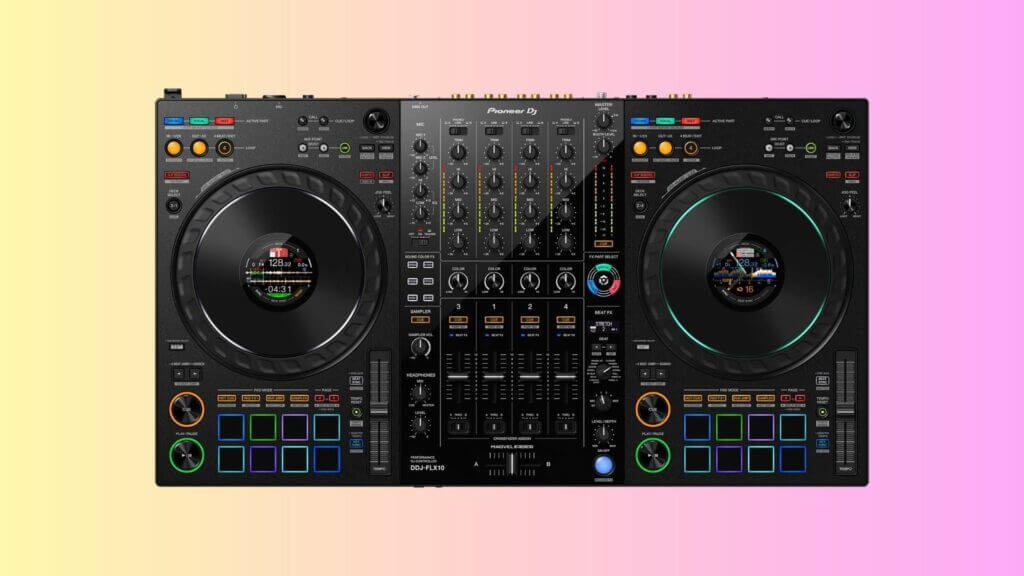
Track Separation Technology /STEMS
Track separation Technology (also known as STEMS for Serato fans) is fast becoming one of the things all new controllers must have included to some extent. The Pioneer DJ DDJ FLX10 takes this pretty far, though maybe not as far as it could go (at least for Serato).
It includes the following Stem implementation:
- Separate Buttons For Available Stems: The feature offers a button for Drums, Instruments, and Vocals separation. It does offer a stem less than other software options, which have been known to give an extra separation for melody or bass.
- Instant Doubles: This feature works across the opposite deck as well as down the layered deck on the same side. They won’t work diagonally from one another, but handling the deck of either side is pretty good. You also change it in the settings whenever you want.
- Part ISO: Also known as “stems on EQs”, this works by holding down on the “Shift” key while tapping on the “Cue” button to switch channels between the low, mid, and high EQ ranges, changing them for the three stems and granting much finer overall control and balance.
- FX Part Select: The FX Part Select feature allows you to decide whether to use Sound Color FX or Beat on your whole sound audio or only a specific stem. This lets you better filter out specific parts of the music or instruments while leaving the vocals entirely intact, creating an acapella. Alternatively, you could remove the vocals and create an instrumental. This is really cool and gives a lot of mix-and-match freedom.
Sound Quality
Lastly, the FLX10’s sound quality is overall quite good. While the Pioneer DJ DDJ-1000 similarly had fairly good sound quality in general, its phono preamps were a bit shaky.
Here, they’ve seen a massive upgrade, clearing a lot of those issues up and giving the sound a significant boost in clarity. Not only did we play around with the sound through normal areas, but we also tried out the new Stretch Beat effect, which was also really impressive.
The stems’ audio quality is probably one of the areas that need a bit of work, but that’s the case for pretty much all DJ software going on at this time. Simply put, this means that what we’re hearing now is the worst it will ever be, which is kind of exciting considering how good it already does sound.
Artwork Display & DJ Logo Display
The artwork display feature exhibits the artwork of the currently playing track. The DJ logo display functionality allows you to display your personal logo or a chosen image on each deck, after transferring it via the Image Transfer Tool available for PC/Mac.
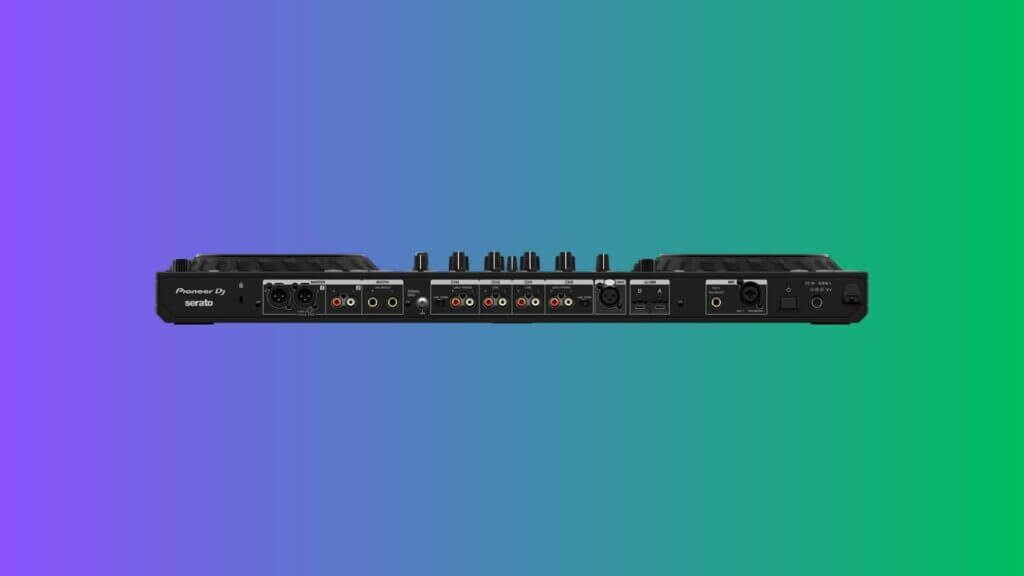
Read this next: DDJ 1000: The Best Pioneer DJ Controller Ever?
Overall Performance
What We Like
- Familiar Look & Feel: If you were interested in a controller that shared the same overall look and feel as its DDJ-1000 and DDJ-1000SRT predecessors, you’re very much in luck. Whether it’s the overall build quality, the jog wheel size, the established hot cue buttons, or simply the layout of everything on the controller, this controller wants you to feel right at home.
- Comes With Stems: Technically referred to as “Track Separation” stems comes with both rekordbox DJ and Serato sides of the FLX10 controller. This lets you create a whole host of different sound setups and divisions, such as separating the Instruments, Drums, or Vocals from a track.
- Improved Sound Quality: If you’re looking for a controller that sounds good – and better than what the DDJ-1000 offered – then you’ll have a lot of fun with what the Pioneer DJ DDJ FLX10 has to offer.
- DMX Lighting: This is a cool inclusion simply for the fact that it uses the now-discontinued RB-DMX1 lighting interface. This makes it pretty much the only way you’re going to use rekordbox DJ Lighting, really giving it that unique “1 in a million” type of vibe. You don’t need any other equipment such as an external DMX interface.
- Can Be Used With Serato DJ Pro: While it’s clear that rekordbox DJ is the main focus of this controller, it’s also just as clear that they didn’t want to have to come out with an “FLX10-SRT” a few years later (they still might). The FLX10 does offer good Serato DJ Pro implementation including Serato Stems, though lacking in other areas like no Mix Point Link.
What We Do Not Like
- Price: The controller costs a bit more compared to the earlier DDJ-1000 and DDJ-1000SRT. If you’re unsure about your budget, you may be better off looking into one of those options instead.
- Rekordbox Native: While I personally am a huge fan of rekordbox DJ, that doesn’t take away the fact that Serato is the bigger name of the two. Though great strides are taken to try and make the Serato DJ crowd happy, it’s still clear that they’re more add-ons to a rekordbox DJ party rather than actual guests. While I imagine Serato fans will certainly get their money’s worth, if they expect the controller to offer equal amounts of love to either software option, they will likely be a bit disappointed.
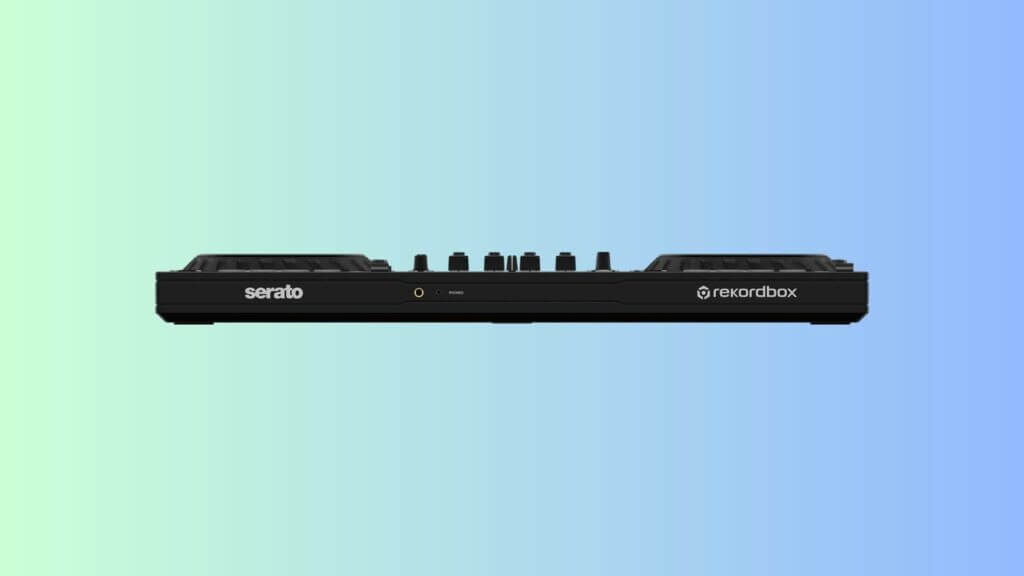
Pioneer DJ DDJ-FLX10: The Verdict
The goal of the Pioneer DJ DDJ-FLX10 was to see if it could successfully surpass the DDJ-1000 and DDJ-1000SRT as the new benchmark standard for all new Pioneer DJ controllers to be compared against. And while there are one or two things you may personally feel are overblown or a bit excessive, it’s certainly clear that they succeeded.
This is a device that is meant for the professional that doesn’t want to constantly look over his shoulder at everything new coming out for at least the next five years as a future-proofed piece of technical mastery.
The controller builds off of many of its predecessors, be they the aforementioned DDJ-1000/SRT, or others like the DDJ-400, DDJ-800, or the DDJ-FLX4 and FLX6, acting as a logical evolution of all of these builds, both individually as well as a collective step up overall.
From the implementation of stems to the simultaneous inclusion of Serato mapping (quite literally giving you the best of both worlds) to its all-around impressive sound quality, I can’t see a ton of controllers really comparing at least in the foreseeable future.
Overall, the only thing that I can see holding a person back is the price, and it’s certainly nothing to scoff at. Priced at a whopping $1,600, the FLX10 is over $500 more than either of the DDJ-1000s. For perspective, there are plenty of smaller quality controllers that go for around $500.
That means you could quite literally pick up two controllers for the price of this one. That’s a hard sell if I’ve ever heard one – and if you’re not interested in all of the crazy features included, you may be better off going for the alternative option.
Ultimately, it comes down to you and what you’re goals are as a DJ.
If you’re just getting started, you’re better off saving your money and getting a quality entry-level controller and some other starter equipment.
For the hobbyist or mid-level performing DJ, the DDJ-FLX10 may be worth your time but only if you’re planning to create slick musical progression and play with all of the different features the controller has to offer.
- Extensive Performance Features
- Jogwheels With Screens
- Professional 4-Channel Mixer
- Integrated Stem Controls
- Stem Quality is Sometimes Average



